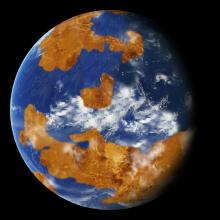Listen to today's episode of StarDate on the web the same day it airs in high-quality streaming audio without any extra ads or announcements. Choose a $8 one-month pass, or listen every day for a year for just $30.
You are here
Morning Venus
Venus is stretching its legs right now. The “morning star” stands farthest from the Sun for its current appearance over the next few days. It climbs into view about three hours before sunrise. And it’s more than a third of the way up the eastern sky by the time it fades from view.
One of the reasons Venus looks so bright is that it’s blanketed by brilliant clouds. They completely hide the surface from view.
The spacecraft that provided our best view through the clouds arrived at Venus 30 years ago today. Over the next few years, Magellan used radar to map about 98 percent of the surface.
The images revealed a landscape dotted by hundreds of volcanoes. Most of them are extinct, but Magellan and later missions found evidence that some of them may still be active.
Magellan’s maps show that, over the last billion years or so, volcanic processes have repaved Venus’s surface. That could have happened quickly. But recent studies say it probably played out over hundreds of millions of years — and may still be going on today.
After its mapping mission was done, Magellan used a technique known as aerobraking to lower its orbit. It dipped into the atmosphere on each orbit, “dragging” it a little farther down with each pass. From the lower orbit, Magellan compiled a map of Venus’s gravity. That gave scientists more information about the planet’s structure and the composition of its crust — painting a better picture of a “hidden” world.
Script by Damond Benningfield





